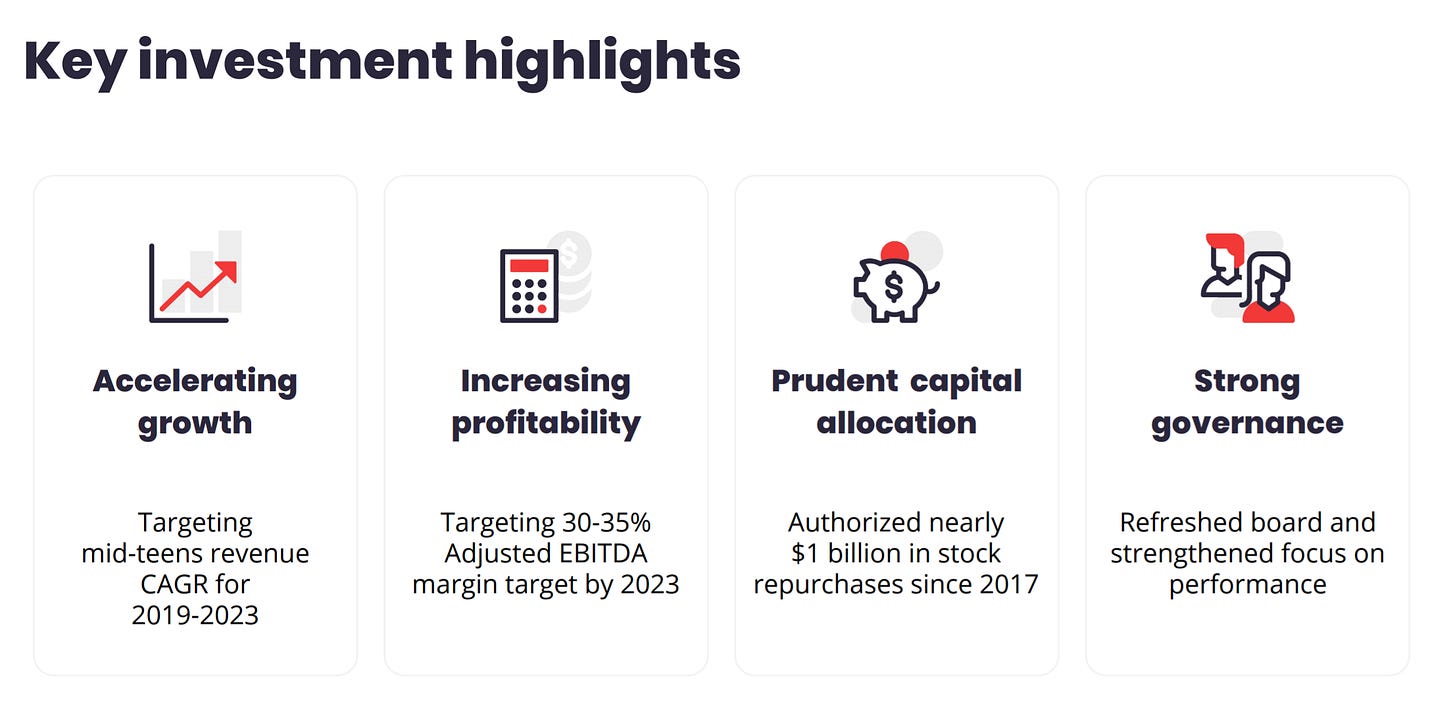Yelp – A Re-Opening Play with Upside
Price Target: $55
Yelp went public in 2012. The stock traded between $22 and $26 on opening day, and just five months ago was trading at a similar level. Obviously, the pandemic was not kind to Yelp’s business, but I think investors may be overly pessimistic about the company’s prospects. While, the stock has rallied in the last three months, I think there’s more upside.
On a side note, I think Yelp serves as a cautionary tale for today’s investors in ‘high growth’ companies. Expectations were high at the time of Yelp’s IPO and the stock tripled by 2014 reaching almost $100. Since then, the stock has never exceeded $50, even though the company has continued to do reasonably well. For many stocks, high expectations translate to low returns.
Business Model and Valuation Assumptions
While Yelp’s average revenue growth has been 10% a year for the last five years, Yelp’s share price has essentially been flat. Yelp’s management team laid out a plan in 2019 to transform the business model to make it less reliant on local sales people in the hope of both increasing revenue and improving margins. Below is a slide from a February 2020 investor presentation laying out their thesis for why Yelp is a good investment.
Obviously COVID through a wrench in these plans, but the latest shareholder letter indicates Yelp is making progress in transforming its business.
Yelp, as you probably know, helps consumers find local businesses. The site has reviews on everything from restaurants and café’s to plumbers and general contractors. They have over 200mm reviews on their site and 96 million unique visitors.
In 2019, 60% of page views were for restaurants and cafes, but they only made up 15% of ad revenue. Conversely, Services (plumbers, electricians etc.) were 10% of page views but made up 50% of ad revenue. In 2020, Services made up 62% of ad revenue as Americans spent more time at home and either made improvements or fixes to their houses.
In 2019, Yelp only monetized 10% of leads (calls, requests for quotes and URL clicks), but this increased to 20% in 2020 and management hopes to continue to grow this number going forward.
I think the biggest threat to Yelp is Google. Yelp’s CEO has said for years that Google is unfairly promoting its own ‘Google My Business’ reviews in search results over those of Yelp and other third party providers. While I sympathize with Yelp’s CEO’s sentiments, Google is probably not going to change its behavior. Yelp is therefore going to need to find a way to continue to be relevant and compelling for both consumers and businesses. My sense is that there will always be a group of consumers (myself included) that trust Yelp reviews more than Google’s, so I’ll bet money Yelp continues to be around in 10 years.
Now that the existential question is out of the way, let’s get to the details of the model.
I model $1B in revenue for 2021 (per management guidance and the same as 2019), growing 14% in 2022, with the growth rate declining by 1% a year to reach 6% in 2030. This results in $2.3B in revenue in 2030.
Management has stated that Yelp is planning to meaningfully improve margins in the next few years, mostly by reducing sales and marketing costs. I therefore model operating margins of 5% in 2021, increasing by 1% / year to reach 10% by 2026 and then staying at that level.
Like many tech companies, Yelp seems to think stock based compensation is not a real expense and not something shareholders should worry about. In 2019, stock based compensation was over $120mm which accounted for more than half the adjusted EBITDA number of $213mm. Just like in my other models, I treat stock based compensation as a number that effects the cash flow, because at the end of the day investors either get diluted by the stock comp, or the company uses cash to buy back shares which then get awarded to employees. Either way, stock based compensation is a very real cost to shareholders and cannot be ignored.
So, while Yelp would like to tout ‘Adjusted EBITDA’ margins improving from 21% in 2019 to 30-35% in 2023, the more realistic view to me is that operating margins improve from 5% in 2019 to 8% in 2024. I have them improve to 10% by 2026 and stay there. My hope is that the pandemic has forced Yelp to reevaluate its cost structure and that margins improve more than modeled, but this is not something I feel comfortable baking into the valuation assumptions.
Valuation Results
Based on these revenue and margin assumptions, and a terminal value FCF multiplier of 20x, I arrive at a per share value of $55 for yelp. As always, the model is available here if you would like to use your own assumptions.
Downside Risks
There have been reports by restaurants of Yelp extorting money from them for favorable ratings. Yelp vehemently denies these accusations and I’m inclined to believe them. However, if it turns out these allegations are true, Yelp’s business is going to be massively compromised (part of the reason I don’t think they’d be dumb enough to do something like this).
Yelp claims digital local advertising spend was $63B in 2019, with restaurants accounting for $8B and Services making up $28B. Yelp was only able to capture $1B of this spend even though the company has been around for 16 years and has been the dominant platform of its kind. This may mean there just isn’t that much room to grow for the company and therefore revenue growth may turn out to be lower than modeled.

